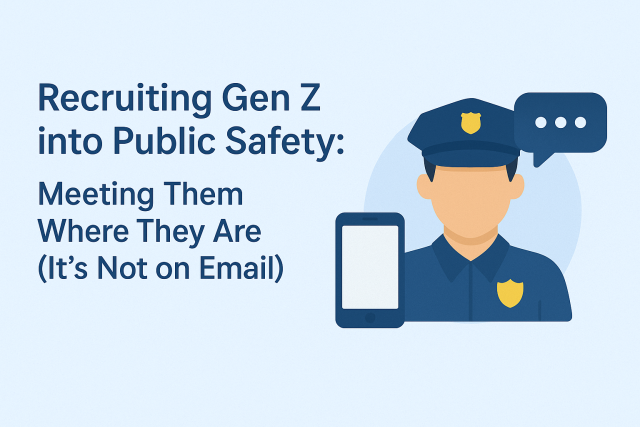As police departments across the nation face unprecedented challenges in recruitment, innovative strategies are essential for attracting qualified candidates.
The Current Landscape of Police Recruitment
Recruitment in law enforcement has evolved significantly over the years. Recent events, societal changes, and increasing public scrutiny have made the job less appealing to potential candidates. In light of these challenges, police departments must adopt new strategies that resonate with today’s job seekers.
Understanding the Recruitment Crisis
The recruitment crisis in law enforcement is not merely a matter of filling vacancies; it’s about attracting individuals who are genuinely passionate about serving their communities. Many departments report alarming statistics, such as significant decreases in applications and high turnover rates. To combat these issues, agencies must understand what motivates candidates to apply and remain engaged throughout the hiring process.
Success Stories in Recruitment
Numerous police departments have seen success through strategic recruitment efforts. For instance, one department reported hiring twenty new officers in just one week, a significant achievement in an era where many agencies struggle to fill positions. This success can be attributed to effective candidate nurturing and engagement practices after bringing on SAFEGUARD Recruiting to assist them.
The Role of Candidate Engagement
Engaging candidates effectively is crucial for converting interest into applications. Departments that excel in recruitment often have robust systems in place to keep candidates informed and motivated throughout the hiring process. This includes providing clear communication about the steps involved in the application and hiring process. SAFEGUARD’s Applicant Tracking System has had tremendous success in this area.
Addressing Physical Fitness Challenges
One common hurdle in police recruitment is the physical fitness requirement. Many candidates struggle with the physical tests, leading to high failure rates. Departments can mitigate this issue by offering training programs and resources to help candidates prepare adequately.
Training and Preparation
Successful departments often provide opportunities for candidates to train and practice before the physical fitness tests. This proactive approach not only prepares candidates but also demonstrates the department’s commitment to their success. By offering personalized training programs, agencies can enhance candidate readiness and reduce drop-off rates.
Evaluating Traditional Recruitment Methods
Many police departments still rely on traditional recruitment methods, such as billboards and bus advertisements. However, these strategies may not yield the desired results. Billboards, while visually appealing, often fail to reach the right audience effectively.
The Limitations of Billboards and Bus Ads
Billboards and bus ads can be costly and challenging to track in terms of effectiveness. Departments may spend substantial amounts on these advertisements without any clear indication of their impact on recruitment. A significant drawback is the inability to measure return on investment, making it difficult to justify continued spending on these methods.
The Shift to Digital Recruitment Strategies
With the limitations of traditional advertising methods, many police departments are shifting towards digital recruitment strategies. Digital marketing allows for targeted campaigns that reach specific demographics more effectively.
Targeted Digital Campaigns
Digital recruitment involves using various online platforms to reach potential candidates. This includes social media, search engine marketing, and dedicated recruitment websites. By leveraging data and analytics, departments can create campaigns tailored to the interests and needs of their target audience.
Benefits of Digital Recruitment
- Increased Reach: Digital platforms allow agencies to reach a broader audience, including those who may not actively seek out law enforcement careers.
- Measurable Results: Tracking metrics such as impressions, clicks, and applications provides valuable insights into the effectiveness of recruitment efforts.
- Engagement: Digital campaigns can foster engagement through interactive content, allowing candidates to learn more about the department and its culture.
Building a Strong Online Presence
A strong online presence is vital for modern police recruitment. Potential candidates often conduct online research before applying, making it essential for departments to showcase their values, culture, and opportunities effectively.
Creating a Dedicated Recruitment Website
A dedicated recruitment website serves as a central hub for information regarding job opportunities, application processes, and department culture. It should be user-friendly, visually appealing, and optimized for search engines to attract organic traffic.
Key Features of a Recruitment Website
- Clear Job Listings: Provide up-to-date information on available positions and application deadlines.
- Engaging Content: Share success stories, testimonials from current officers, and information about the department’s mission and values.
- Easy Application Process: Simplify the application process with online forms and clear instructions.
Utilizing Social Media for Recruitment
Social media platforms have become powerful tools for recruitment. They allow departments to connect with potential candidates in a more informal and engaging manner.
Effective Social Media Strategies
To maximize the impact of social media recruiting, agencies should implement the following strategies:
- Targeted Advertising: Utilize demographic targeting to reach individuals likely to be interested in law enforcement careers.
- Engaging Content: Share videos, images, and posts that highlight the department’s culture and community involvement.
- Interactive Campaigns: Encourage interaction through polls, Q&A sessions, and live streams to engage with potential candidates.
Measuring Success and Adjusting Strategies
To ensure the effectiveness of recruitment strategies, departments must regularly measure their success and adjust their approaches accordingly. This involves tracking key performance indicators (KPIs) and analyzing data to identify trends and areas for improvement.
Key Performance Indicators for Recruitment
Some essential KPIs to track include:
- Application Rates: Monitor the number of applications received before and after implementing new strategies.
- Candidate Engagement: Analyze how candidates interact with recruitment content and communications.
- Hiring Rates: Evaluate the success of recruitment efforts by tracking the number of hires made over specific periods.
Conclusion
In an era of recruitment challenges for law enforcement, adopting innovative strategies is crucial for attracting qualified candidates. By shifting focus from traditional methods to targeted digital campaigns, enhancing candidate engagement, and utilizing social media effectively, police departments can improve their recruitment efforts. As the landscape continues to evolve, agencies must remain adaptable and proactive in their approach to attracting the next generation of law enforcement professionals.
For more information on effective police recruitment strategies, visit SAFEGUARD Recruiting.



